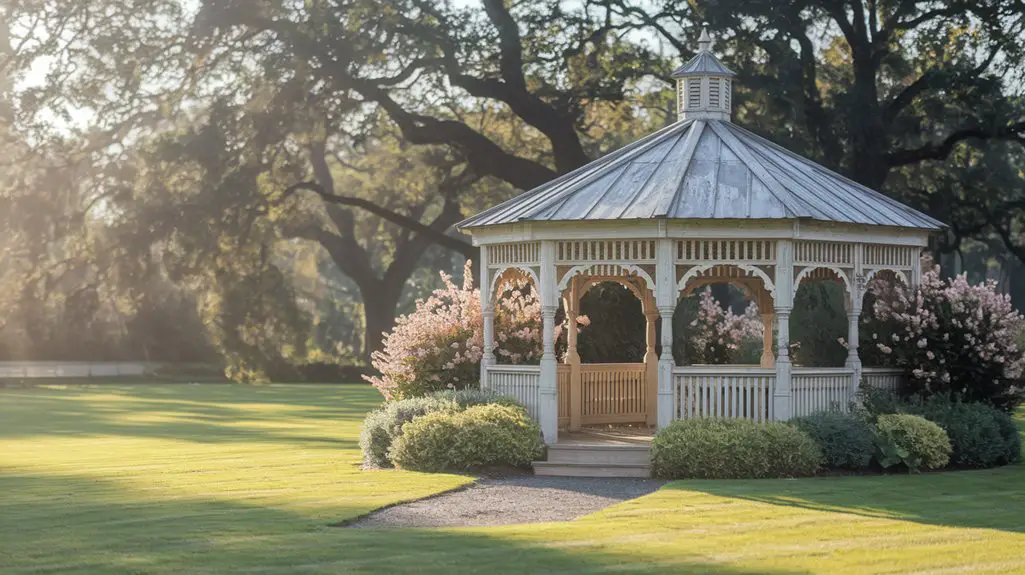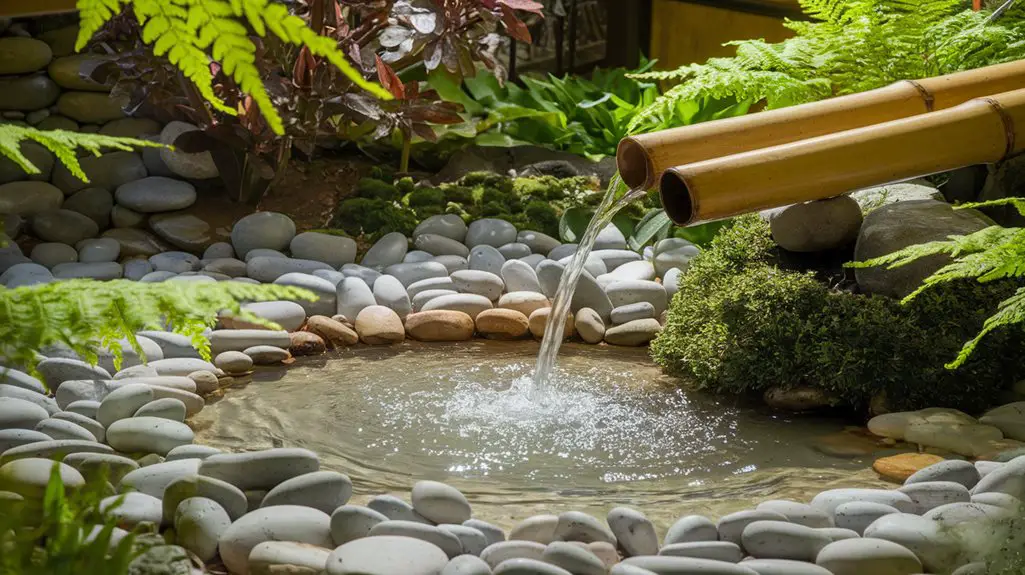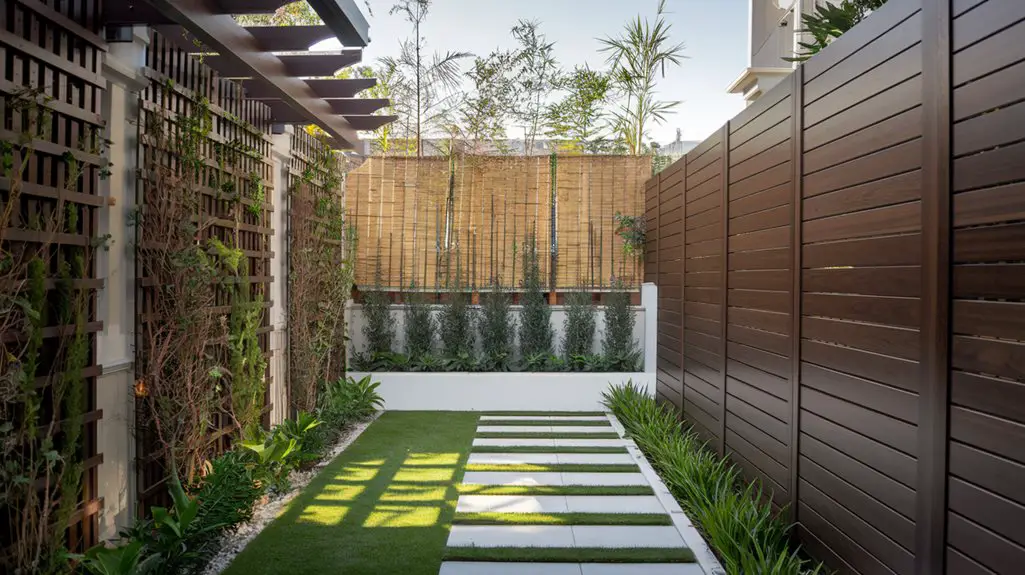You'll find that vintage gazebo designs offer far more than mere shelter in your outdoor space. These architectural elements introduce a focal point of historical resonance while defining spatial boundaries with purposeful elegance. The integration of period-specific detailing—from intricate spindlework to corbeled eaves—establishes visual hierarchy and dimensional complexity within your landscape composition. The question remains: how will you balance authenticity with practical functionality in your selection?
The Timeless Appeal of Victorian-Era Gazebo Architecture
Elegance personified, Victorian-era gazebos represent the pinnacle of ornamental garden architecture from the mid-to-late 19th century.
These octagonal or hexagonal structures feature intricate fretwork, latticework balusters, and steep multi-tiered roofs that exemplify the period's dedication to craftsmanship.
You'll notice the strategic positioning of these structures—typically at garden terminus points or elevated sites—maximizing sightlines while providing shelter.
The architectural vocabulary includes dentil moldings, spindle work, and cupolas that establish visual rhythm through repeated elements.
Most authentic Victorian gazebos incorporate a 3:4 height-to-width ratio, allowing for ideal interior vertical space while maintaining proper proportions.
These structures aren't merely decorative; they serve as functional microclimates, offering shade through calculated roof overhangs of 18-24 inches.
Enhancing Garden Aesthetics With Ornate Vintage Details

While modern garden structures emphasize simplicity, vintage gazebos derive their aesthetic power from ornamental details that establish focal points throughout the landscape. You'll find these architectural elements create visual rhythm and historical resonance within your garden space. Incorporating artful outdoor displays can further elevate the ambiance of your garden.
| Detail Element | Spatial Impact |
|---|---|
| Fretwork | Filters dappled light patterns |
| Finials | Draws eye upward, enhancing verticality |
| Corbels | Creates transitional depth at junctions |
| Balustrades | Defines perimeter without visual obstruction |
| Decorative brackets | Softens structural angles while adding support |
When positioning your vintage gazebo, consider sightlines from multiple vantage points. The ornate details should be visible from primary viewing areas, allowing the structure to serve as both destination and visual anchor. The patina and weathering of authentic vintage elements adds temporal dimension that new constructions cannot replicate.
Durability and Craftsmanship of Traditional Gazebo Designs
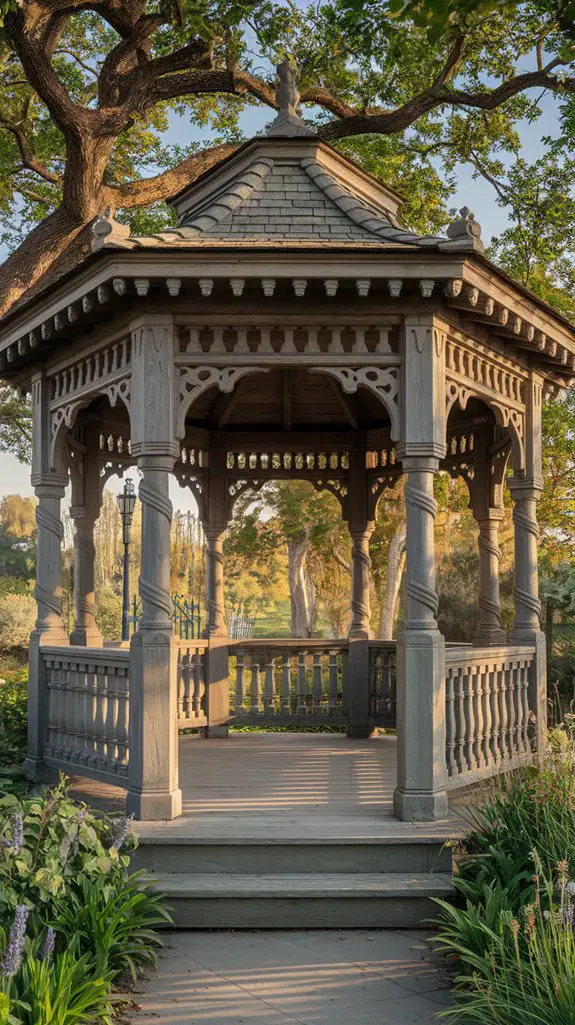
Beyond aesthetic appeal, the structural integrity of vintage gazebo designs represents a proof to historical building methodologies that have weathered decades—even centuries—of environmental exposure.
When you invest in a traditional gazebo, you're acquiring a structure engineered with time-tested joinery techniques and material selection principles that modern mass-produced alternatives often lack.
- Hand-carved balustrades and ornamental brackets that connect you to craftsmanship lineages spanning generations
- Weather-resistant hardwood selection that adapts to seasonal expansion and contraction cycles
- Mortise and tenon joints that maintain structural integrity without reliance on modern fasteners
- Cantilevered roof systems that efficiently channel precipitation away from the structure's core
- Strategic ventilation elements that prevent moisture accumulation while maintaining thermal comfort
Additionally, these vintage designs often include charming rustic pergola designs that enhance the overall aesthetic of your landscape.
Creating Intimate Gathering Spaces With Historical Flair
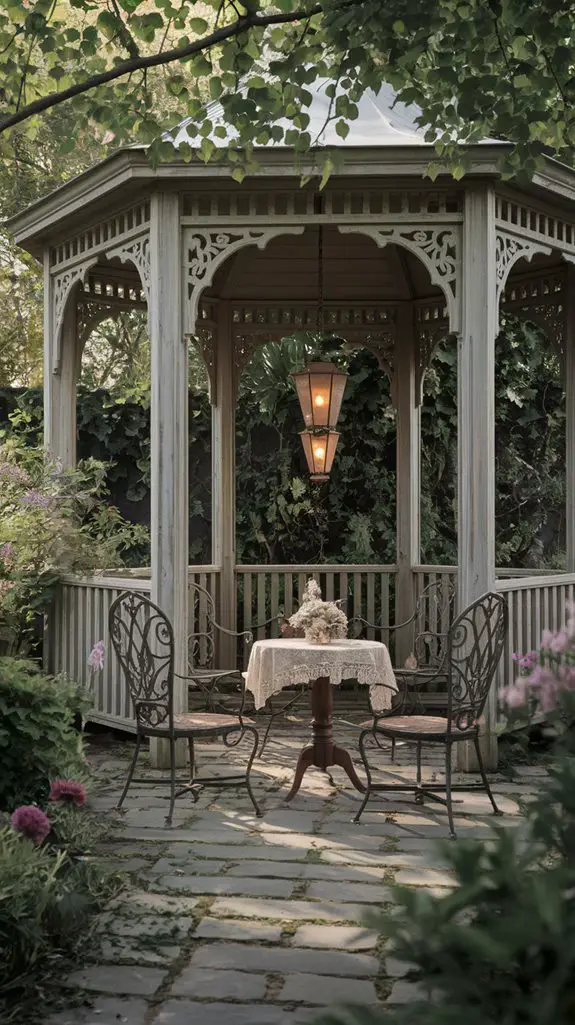
When transforming your outdoor area into an intimate gathering space, vintage gazebo designs offer architectural foundations that seamlessly blend historical storytelling with functional socialization zones. You'll find these structures create natural focal points while providing spatial definition that contemporary designs often lack. Incorporating creative gazebo ideas can further enhance the aesthetic appeal and functionality of your outdoor oasis.
| Style Era | Spatial Features | Social Functionality |
|---|---|---|
| Victorian | Ornate railings, pitched roofs | Encourages face-to-face seating |
| Edwardian | Open-air design, wide entrances | Facilitates fluid movement |
| Art Nouveau | Curved elements, organic motifs | Creates conversation pockets |
Position your vintage gazebo to maximize sight lines while maintaining proximity to your home's architectural elements. Consider integrating period-appropriate lighting fixtures to extend usability into evening hours. The historical proportions—typically more intimate than modern counterparts—naturally foster conversation and connection while providing shelter that doesn't overwhelm your landscape's visual hierarchy.
Selecting the Perfect Materials for an Authentic Vintage Look
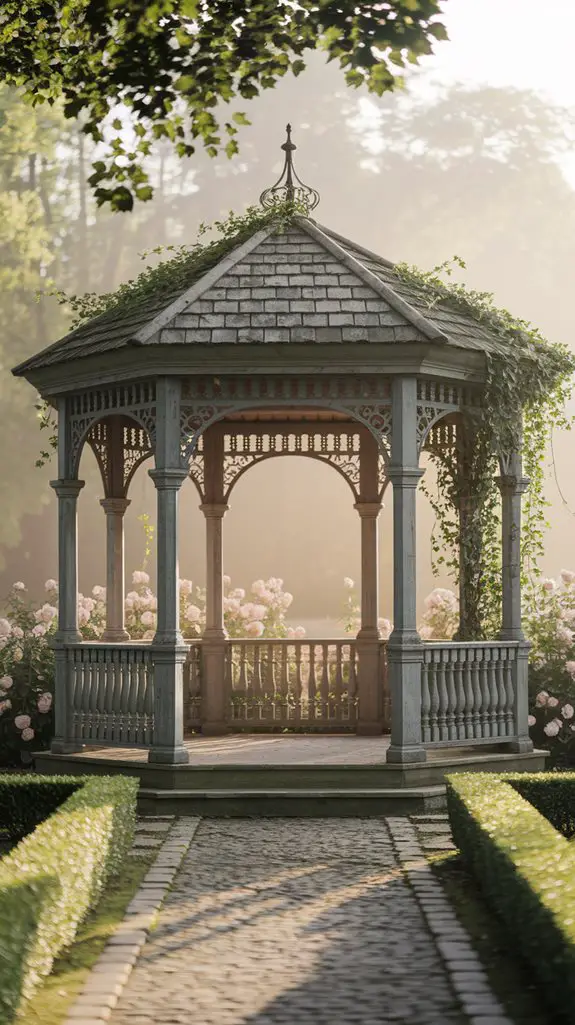
To achieve historically accurate representation in your vintage gazebo, you'll need to select materials that honor both the craftsmanship and aesthetic sensibilities of your chosen era. Focus on period-appropriate woods like cedar, cypress, or redwood that develop distinguished patinas over time.
- Salvaged architectural elements that carry authentic weathering patterns
- Hand-forged ornamental ironwork with period-specific filigree detail
- Lattice panels cut to traditional diamond or square configurations
- Copper or zinc flashing and finials that will patinate gracefully
- Climate-appropriate millwork proportioned to historical specifications
Consider dimensional accuracy when sourcing materials—modern lumber dimensions differ from historical standards.
For Victorian designs, incorporate ornate spandrels and scrollwork. Arts and Crafts gazebos demand quarter-sawn oak with exposed joinery. Colonial revival styles require classical columns with proper entasis and traditional balustrades at historically accurate heights.
Blending Old-World Charm With Modern Landscape Elements
While preserving historical authenticity in your vintage gazebo remains paramount, integrating it harmoniously with contemporary landscape elements creates a dynamic outdoor space that honors tradition without sacrificing modern functionality.
Position your gazebo at the intersection of sight lines to establish a visual focal point. You'll achieve ideal integration by creating connecting zones using crushed stone pathways that connect to modern paver patios.
Incorporate period-appropriate plantings like hydrangeas or boxwoods in the gazebo's immediate vicinity, then gradually shift to contemporary specimens as distance increases.
Consider implementing subtle LED uplighting to accentuate architectural details while providing practical illumination. Weather-resistant composite materials with wood-grain finishes offer durability without compromising aesthetic integrity.
For maximum cohesion, echo gazebo details—finials, lattice patterns, or color schemes—in surrounding landscape elements to create visual continuity throughout your property. Additionally, incorporating elements like modern outdoor kitchen concepts can enhance the functionality of your outdoor space while maintaining its vintage charm.
Seasonal Versatility of Classic Gazebo Structures
Although often appreciated for their warm-weather appeal, vintage gazebo structures demonstrate remarkable adaptability across all seasons with proper preparation and strategic modifications.
You'll find these architectural elements shift seamlessly through temporal variations while maintaining structural integrity and aesthetic cohesion with your landscape.
- Winter's crystalline formations transform lattice details into frost-adorned galleries
- Spring raindrops cascade harmoniously from tiered rooflines, creating natural water features
- Summer shade creates microclimate cooling zones beneath ornamental cupolas
- Autumn's golden light filters through decorative balustrades, casting geometric shadows
- Holiday illumination accentuates period-specific architectural elements year-round
Consider weatherproofing historic wood components with period-appropriate sealants while maintaining breathability.
Incorporate removable storm panels during inclement weather without compromising the gazebo's authentic silhouette.
Strategic placement relative to deciduous trees maximizes seasonal solar gain and protection. Additionally, adding water features can further enhance the ambiance while also contributing to noise reduction in your outdoor space.
Conclusion
You've meticulously planned your contemporary landscape with precision, yet it's the weathered vintage gazebo that paradoxically becomes its defining element. While you've invested in cutting-edge irrigation systems and sustainable hardscaping, it's this architectural anachronism that establishes your outdoor space's genius loci. Your gazebo's timeworn patina and period-specific joinery don't merely occupy spatial coordinates—they transcend them, creating a temporal dimension your ultra-modern elements can't achieve alone.

